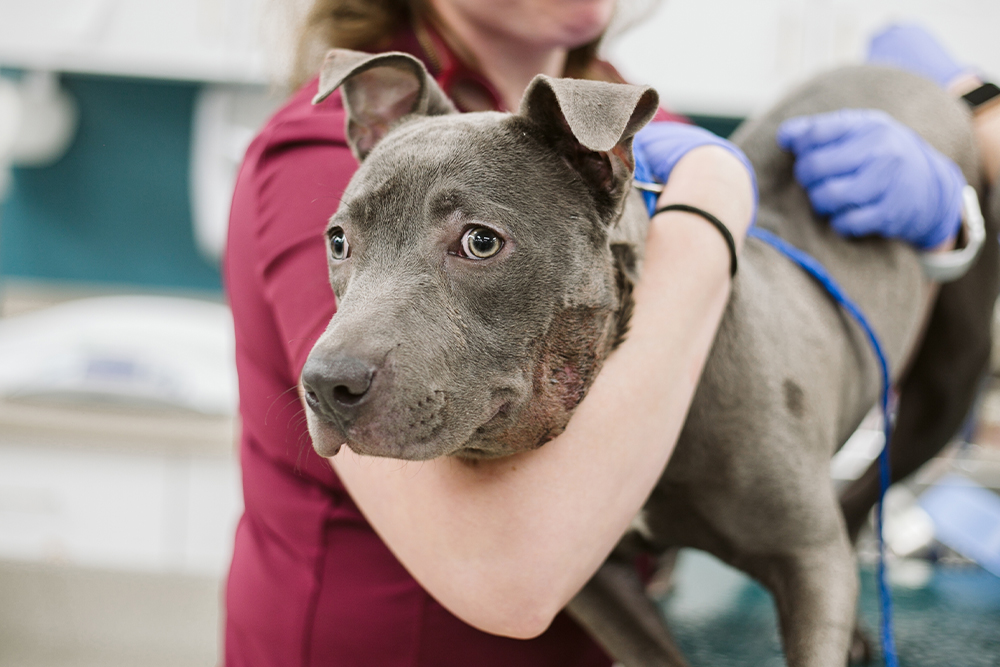From Surgery to Prevention: Helping Pets Overcome Bladder Stones Safely
Finding out that a dog or cat has bladder stones can feel overwhelming. One day there might be a small accident in the house, and the next, there’s a trip to the emergency hospital to discuss urinary obstructions or possible surgery.
At the Veterinary Emergency and Specialty Center of Northern Arizona, we know how frightening urinary issues can be for families. That’s why our 24-hour emergency and specialty team is always ready to help. With advanced diagnostics, including Northern Arizona’s only CT scanner, we provide world-class care for both urgent cases and long-term prevention.
Understanding Bladder Stones in Pets
Bladder stones, also called uroliths, are mineral formations that develop inside the bladder. These stones can range from tiny grains to large rock-like masses. Each time a pet urinates, the stones cause irritation, and if left untreated they may lead to infections or dangerous blockages.
Bladder stones differ from kidney stones, which form in the kidneys. Bladder stones remain in the bladder or urethra, where they directly affect urination and are a common cause of urinary problems in dogs and cats.
What Causes Bladder Stones in Pets?
There is no single cause behind bladder stones. Multiple factors often work together to create the right conditions for stones to form.
- Infections: Urinary tract infections can change urine pH and encourage certain crystals to clump together.
- Pet diet: Diets high in certain minerals and low in moisture may increase risk.
- Animal breeds: Some breeds, such as Dalmatians and Miniature Schnauzers, are predisposed to specific stone types.
- Certain conditions: Metabolic issues like diabetes, obesity, or liver disease can raise calcium levels or alter urine chemistry.
- Urine pH imbalances: When urine chemistry is off balance, crystals are more likely to form.
Why Bladder Stones in Pets Are Serious
Bladder stones can cause much more than mild discomfort. They can block urine flow, creating life-threatening emergencies. Small male dogs and male cats are particularly at risk for obstruction.
If left untreated, stones may lead to:
- Pain each time a pet urinates
- Complete blockage preventing urination altogether
- Repeated urinary tract infections (bacteria can hide within stones)
- Kidney damage if urine backs up into the kidneys
Our hospital provides 24/7 emergency and critical care, ensuring that if your pet experiences a urinary obstruction, immediate treatment is always available.
How to Recognize the Signs of Bladder Stones in Pets
Pets do not always show obvious pain, but warning signs include:
- Urinating more often but producing only small amounts
- Straining or appearing uncomfortable while urinating
- Blood in the urine or urine that appears cloudy
- Excessive licking of the urinary opening
- Changes in appetite or energy levels
Any of these symptoms may indicate a urinary emergency and should be evaluated right away. Learn more about urinary tract symptoms and when to seek immediate care.
How Bladder Stones Are Diagnosed
Accurate diagnosis is essential to determine whether surgery is the safest and most effective option. Veterinarians typically combine multiple tools to confirm the presence of stones and create a treatment plan:
- A physical exam may reveal discomfort or a distended bladder.
- A urinalysis and urine culture can identify crystals, bacteria, and pH imbalances.
- Imaging through X-rays, ultrasound, or CT scanning shows the size, location, and number of stones. CT scans, in particular, offer highly detailed images that are especially valuable when planning surgery.
These diagnostics not only confirm the presence of stones but also help the veterinarian assess whether there are complicating factors- such as infection, blockage, or multiple stones- that may make surgery the best option.
Treatment Options for Bladder Stones
The right treatment depends on the stone’s type, size, and whether a blockage is present.
Medical Dissolution
Some stones, especially struvite stones, can be dissolved with a prescription diet that changes urine pH and reduces crystal-forming minerals. Close monitoring is required to confirm progress, and preventing infection is critical during this process.
Surgical Removal (Cystotomy)
For many pets, especially those with large, multiple, or obstructive stones, surgical removal is the most reliable solution. This common procedure, called a cystotomy, involves making an incision in the bladder so that the stones can be removed directly and completely.
During surgery:
- The veterinarian carefully opens the bladder and flushes out any stones or debris.
- The bladder lining is inspected for damage or infection.
- Special care is taken to remove every stone, even small fragments, to reduce the risk of recurrence.
After surgery, the removed stones are sent to a laboratory for analysis. Identifying the stone’s exact composition helps determine why they formed and how to prevent them from returning. For example, struvite, calcium oxalate, and urate stones each have different dietary and medical management strategies. This information allows the veterinarian to create a tailored prevention plan for each pet.
Recovery from cystotomy usually involves a short hospital stay, pain management, antibiotics if infection is present, and restricted activity while the bladder heals. Most pets recover well and experience rapid relief from the discomfort caused by the stones.
Catheterization
In emergencies where a stone blocks urine flow, catheterization may provide temporary relief by restoring urine flow. This step is often followed by surgical removal or another definitive treatment.
Long-Term Prevention
Once the stones have been treated, preventing recurrence becomes the priority. A personalized plan may include:
- Prescription diets to keep urine chemistry balanced.
- Encouraging hydration with fresh water or pet fountains.
- Regular follow-up visits and imaging to check for early signs of recurrence.
- Managing underlying conditions such as urinary tract infections or metabolic disease.

Common Questions from Pet Owners About Bladder Stones
Can bladder stones go away on their own?
No. Stones rarely dissolve without medical or surgical treatment.
Can food prevent all stones?
Not all. While some stones respond to diet, others require surgery.
Will stones come back?
Some pets are more prone to recurrence, but a prevention plan significantly lowers the risk.
How quickly do stones form?
Depending on type and health status, stones may form within weeks to months.
Moving Forward Together
Bladder stones can be stressful, but they don’t have to define a pet’s health or comfort. With prompt diagnosis, effective treatment, and a long-term prevention plan, pets can return to their favorite routines without unnecessary pain.
At the Veterinary Emergency and Specialty Center of Northern Arizona, our team is here to support both pets and families through emergencies and recovery. Whether your pet needs immediate care for a blockage or ongoing support to prevent recurrence, we’ll work with you to provide the highest standard of veterinary medicine and compassionate care.
Contact us anytime, or meet our dedicated team to learn more about how we can help your pet feel their best.







Leave A Comment